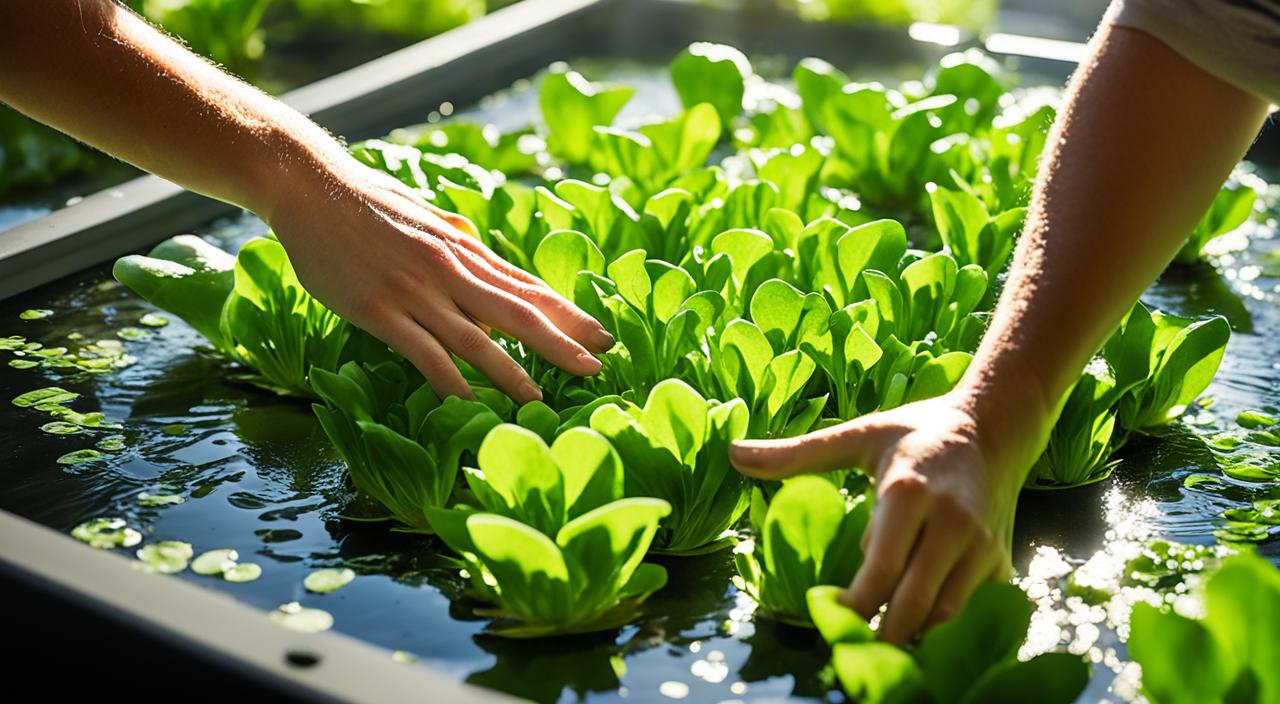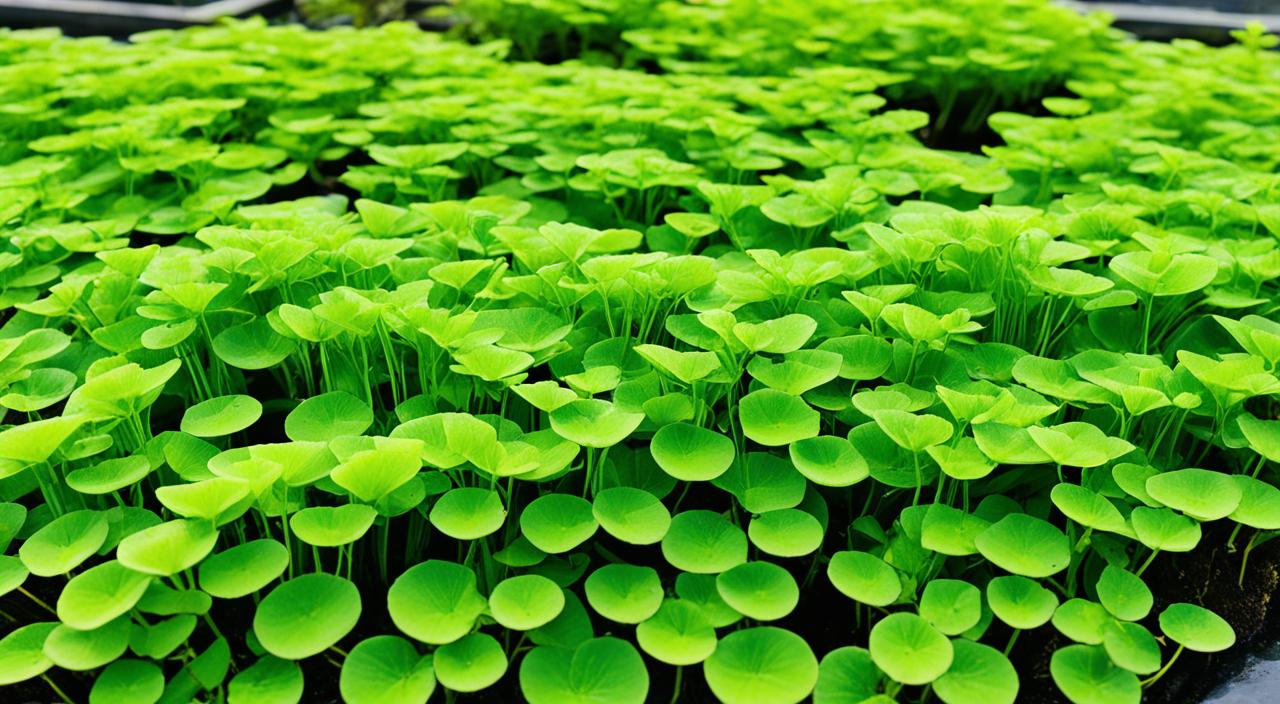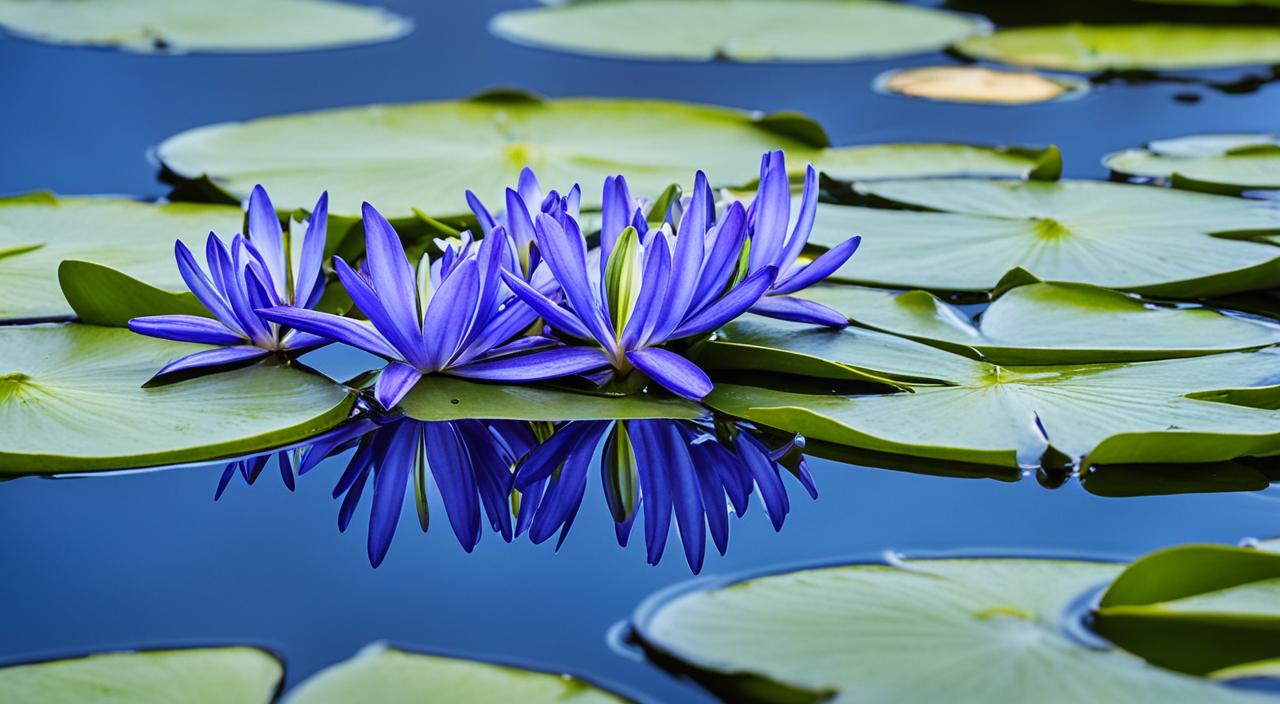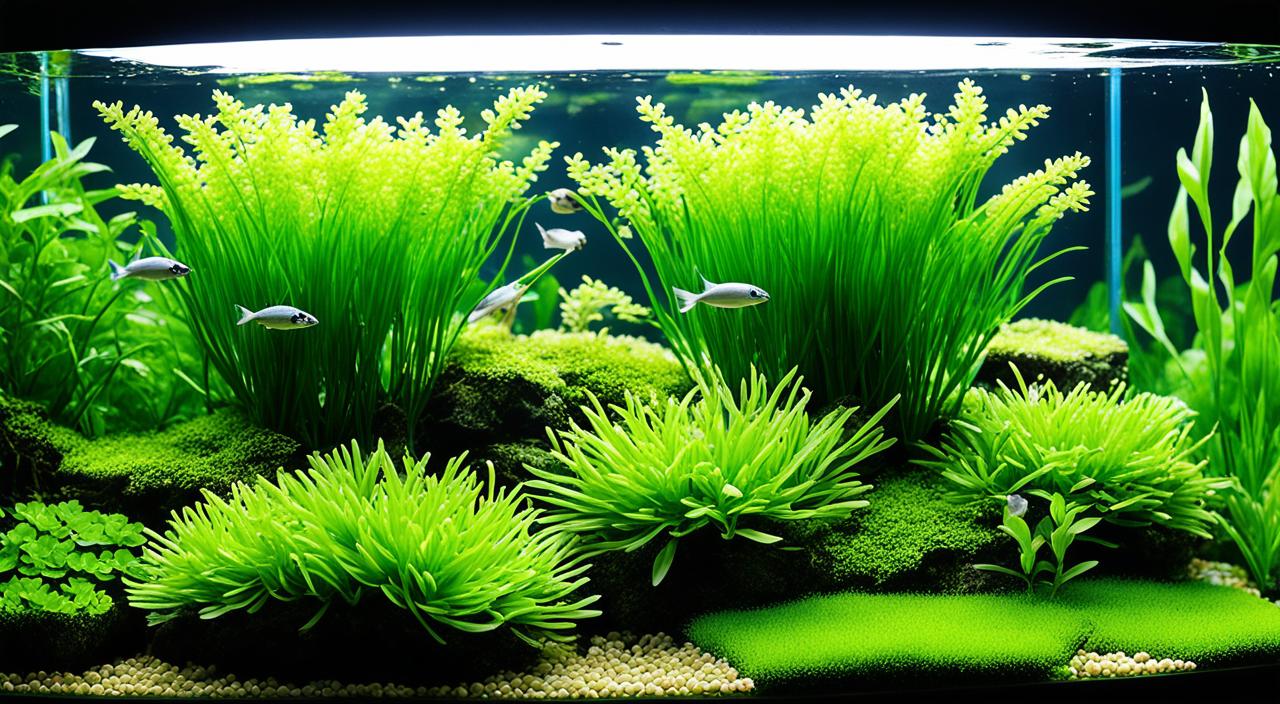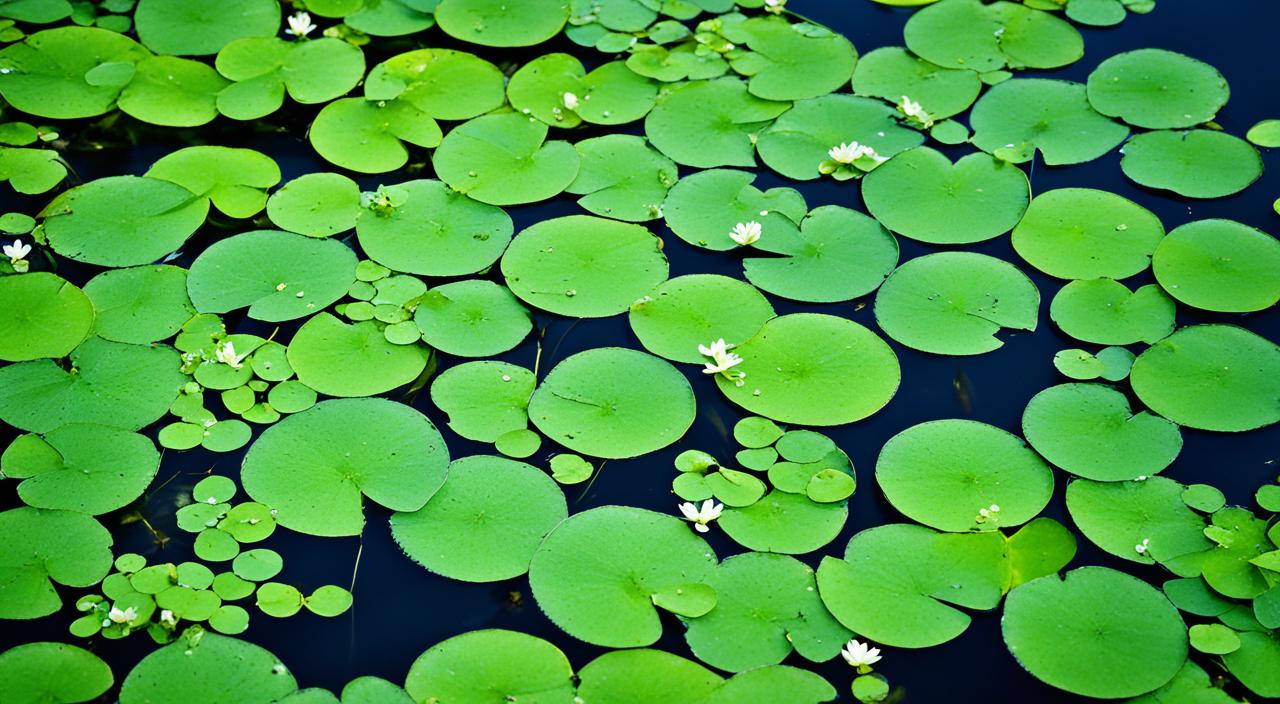Greetings, fellow aquatic enthusiasts! Today, I will dive into the fascinating world of water lettuce and Pistia stratiotes. This versatile floating plant has become a beloved addition to many ponds and aquariums due to its unique characteristics and low-maintenance nature.
Water lettuce, native to the global tropics and subtropics, is a true beauty with its wavy, light green leaves that add a touch of elegance to any aquatic environment. Not only does it create a lush and natural appearance, but it also provides numerous benefits to the overall health of your pond or aquarium.
Join me as we explore the origins and habitat of water lettuce, its morphological characteristics, ideal placement and lighting requirements, compatible tank mates, and essential care tips for its well-being. Let’s unlock the secrets to successfully nurturing this stunning floating plant!
Key Takeaways:
- Water lettuce, scientifically known as Pistia stratiotes, is a popular floating plant for ponds and aquariums.
- It originates from the global and subtropics, and its native distribution is unclear.
- Water lettuce forms a free-floating rosette with wavy light green leaves and long feathery roots.
- Proper placement and lighting are essential for the healthy growth of water lettuce.
- Compatible tank mates include small community fish and invertebrates, while larger herbivorous fish should be avoided.
Brief Overview of Water Lettuce (Pistia stratiotes)
Water lettuce, also known as Pistia stratiotes, is a low-maintenance aquatic plant highly valued for enhancing the health and aesthetics of ponds and aquariums. It has a floating growth habit and attractive wavy leaves that create a lush and natural appearance.
Water Lettuce (Pistia stratiotes) Information Table:
| Characteristics | Description |
|---|---|
| Scientific Name: | Pistia stratiotes |
| Common Names: | Water Lettuce, Water Cabbage, Nile Cabbage |
| Origin: | Tropical and subtropical regions worldwide |
| Height: | 1-6 inches (2.5-15 cm) above water surface |
| Growth Rate: | Fast |
| Colour: | Light green to pale green |
| Aquarium Placement: | Surface (floating) |
| Water Type: | Freshwater |
| pH: | 6.5 – 7.5 |
| Care Level: | Easy |
| Light Requirements: | It is not necessary, but it can benefit from CO2 in densely planted tanks. |
| CO2 Requirements: | It is not necessary, but it can benefit from CO2 in densely planted tanks |
| Temperature: | 70-80°F (21-27°C) |
| Flow Rate: | Low to moderate (strong currents can damage the leaves or push the plant underwater) |
| Propagation: | Absorbs nutrients from the water; additional fertilization can promote growth but is not necessary in nutrient-rich environments. |
| Feed Type: | It is unnecessary but can benefit from CO2 in densely planted tanks. |
The light requirements for Water Lettuce are moderate to high. It thrives under a PAR (Photosynthetically Active Radiation) of 50-70 µmol/m²/s. The ideal Kelvin scale for promoting good colour and growth is between 5000-7000K, simulating natural daylight and effectively supporting photosynthesis. A 3000-5000 lux range is generally sufficient for healthy growth, though Water Lettuce is quite adaptable and can tolerate varying light conditions.
As a floating plant, water lettuce helps to provide shade and cover for aquatic organisms, reduce algae blooms by blocking sunlight, and absorb excess nutrients from the water, thereby improving water quality. It also benefits fish and other aquatic creatures by providing shelter and a food source.
Water lettuce is relatively easy to care for and can thrive in various water conditions, making it a popular choice for experienced and novice aquatic enthusiasts.
Origins and Habitat
Water lettuce is believed to have originated from the global tropics and subtropics, although its exact native distribution is not entirely clear. It is thought to have ancient uses as medicine for humans and fodder for cattle and pigs, which may have contributed to its widespread distribution in countries with tropical climates.
Water lettuce is commonly found in slow-moving water bodies such as ponds, lakes, swamps, and irrigation canals. It can tolerate various conditions, including soft to moderately complex water, and prefers a neutral to slightly alkaline pH.
Water lettuce can be propagated through vegetative fragmentation, where plant fragments or offshoots on stolons can grow into new plants. It can also produce wind-pollinated seeds and disperse through water, potentially colonising new areas.
Morphological Characteristics
Water lettuce is a floating aquatic herb that belongs to the family Araceae. It has distinctive morphological characteristics that make it easily recognizable. The plant features wavy or scalloped leaves with thick and light green foliage. The leaves are covered in short hairs and have a water-repellent surface. They can reach one foot long and are attached at the base, forming a free-floating rosette. Water lettuce also has long, feathery roots that hang beneath the rosette of leaves. The plant produces small and inconspicuous flowers that are borne in a spathe and spadix arrangement. The flowers are sheathed by a white spathe and a leaf-like bract, and the greenish spadix contains separate male and female flowers. Each fruit can contain up to 20 tiny golden-brown seeds. Water lettuce is known for its rapid growth and ability to form dense mats on the water’s surface.
Placement And Lighting
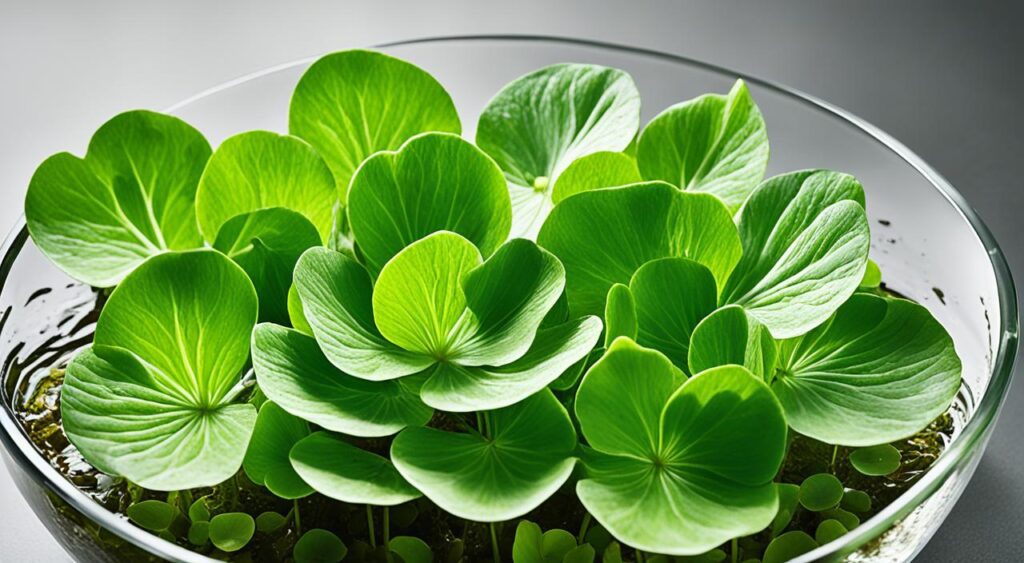
When placing water lettuce in your pond or aquarium, it is essential to consider its unique growth habits and lighting requirements. Water lettuce is a floating plant, so it should be placed on the water’s surface. It can spread quickly and form dense mats, so ensure enough space to grow without overcrowding other plants or blocking access to water.
In terms of lighting, water lettuce prefers full sunlight or dappled light in high-heat conditions. To thrive, it requires around 11 to 12 hours of light exposure per day. However, too much direct sunlight can cause the leaves to burn, so providing shade or adjusting the lighting is essential.
By placing water lettuce in the optimal location and providing the right amount of light, you can ensure that it thrives and contributes to the overall beauty of your aquatic environment.
What Are Good Tank Mates?
Water lettuce can coexist with various aquatic organisms and can be a beneficial addition to any aquarium ecosystem. Many fish species appreciate the presence of water lettuce as it provides cover, shade, and a natural environment that mimics their natural habitat.
Good Tank Mates
Some good tank mates for water lettuce include:
- Guppies
- Tetras
- Rasboras
- Corydoras catfish
- Loaches
- Snails
- Shrimp
These species can thrive in the presence of water lettuce and enhance the overall balance of the aquarium ecosystem.
Fish Species To Avoid
However, avoiding fish species known to nibble on or damage the plant is essential. Larger herbivorous fish like goldfish and cichlids may eat the roots or leaves of water lettuce and hinder its growth. It is essential to carefully consider the compatibility of fish species before introducing them to a tank with water lettuce.
Feeding (Fertilization)
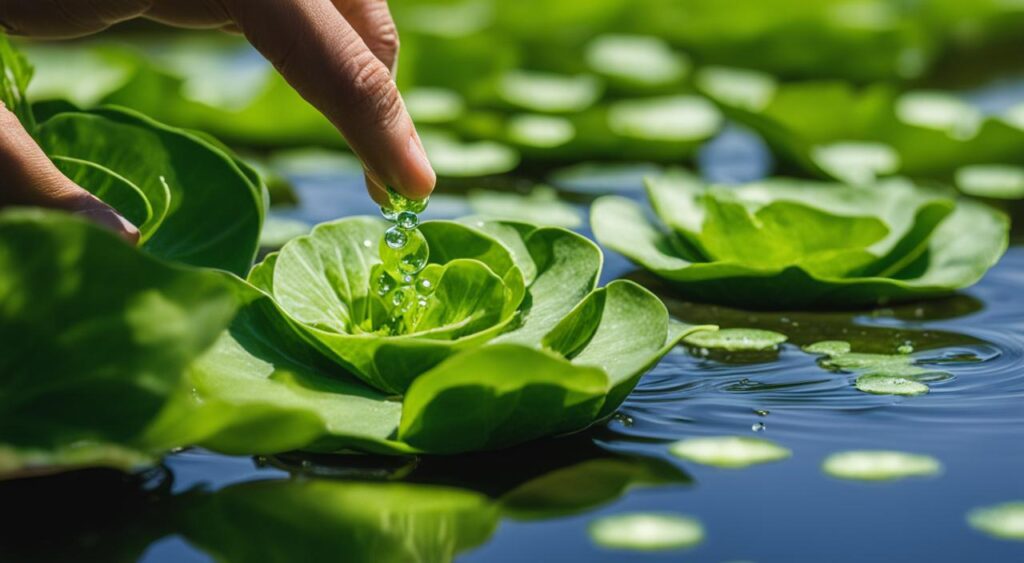
Water lettuce is a low-maintenance plant that does not require regular feeding or fertilization. However, providing some nutrients can promote healthier growth and enhance the plant’s overall appearance. You can use liquid fertilizers formulated explicitly for aquatic plants to feed water lettuce. These fertilizers should be added to the water as directed on the packaging, usually in small amounts periodically.
Following the recommended dosage instructions is essential to avoid over-fertilization, which can lead to algae blooms and other water quality issues. As for how much and how often to feed water lettuce, it is recommended to start with small amounts and monitor the plant’s response. Adjust the feeding frequency and quantity based on the plant’s growth rate and overall health.
Remember that water lettuce can derive some nutrients from the water and the fish waste in the aquarium, so additional feeding may not always be necessary.
CO2 Injection
CO2 injection is a technique commonly used by aquarium enthusiasts to enhance the growth and health of aquatic plants, including water lettuce. It involves introducing carbon dioxide into the aquarium water to provide an additional carbon source that plants need for photosynthesis. Several CO2 injection systems are available, each with advantages and considerations.
Types
The most common types include pressurized CO2 systems and DIY CO2 systems.
Pressurized CO2 systems: These systems use a canister of compressed CO2 gas. They offer greater control over CO2 levels and can deliver a consistent supply of carbon dioxide to the plants more efficiently. However, they require an initial investment and regular maintenance to ensure proper functioning.
DIY CO2 systems: These systems utilize homemade yeast-based CO2 generators. They can be more cost-effective than pressurized systems but may require more frequent adjustments and can be less reliable in delivering a consistent CO2 supply.
When using CO2 injection for water lettuce, monitoring the CO2 levels and ensuring they are within the optimal range for the plant’s growth is essential. Proper CO2 supplementation can promote faster growth, lusher foliage, and better overall health for water lettuce.
Care
Proper care is essential for maintaining the health and vitality of water lettuce in an aquarium. Several key factors should be considered, including planted tank parameters, water quality, filtration, and flow.
Planted Tank Parameters
Regarding planted tank parameters, it is vital to provide appropriate lighting, substrate, and CO2 supplementation to promote plant growth. Water lettuce thrives in freshwater conditions with a neutral to slightly alkaline pH. Maintaining stable water temperatures, ideally between 70 and 80 degrees Fahrenheit, is also essential.
Water Quality
Monitoring water quality parameters such as ammonia, nitrite, nitrate, and pH levels is crucial for the well-being of water lettuce and other aquarium inhabitants. Keeping these parameters in check helps create an environment that supports water lettuce’s growth and overall health.
Filtration
Filtration is vital in maintaining water clarity and removing excess nutrients that can contribute to algae growth. A combination of mechanical and biological filtration is recommended for optimal water quality. Mechanical filtration removes debris and particulate matter, while biological filtration promotes the growth of beneficial bacteria that help break down organic waste.
Flow
Ensuring proper water flow within the aquarium is vital for distributing nutrients and oxygen evenly and preventing stagnant areas where debris can accumulate. Strong water flow can also help maintain a healthy aquatic ecosystem by simulating a natural environment and preventing the establishment of harmful bacteria or parasites.
Aquarium Maintenance
Regular aquarium maintenance is crucial for water lettuce’s long-term health and success and the entire aquatic ecosystem. By implementing a consistent maintenance routine, you can ensure a thriving and beautiful aquarium environment. This section will cover essential aspects of aquarium maintenance, including testing water conditions, setting up the aquarium tank, and water lettuce propagation techniques.
Testing Water Conditions
It is essential to regularly test the water conditions in your aquarium to ensure optimal parameters for the growth and health of water lettuce. Test kits are readily available and provide information on critical parameters such as ammonia, nitrite, nitrate, pH, and temperature. Monitoring these parameters will help you identify any deviations and take appropriate actions to correct them. Maintaining stable and proper water conditions is vital for aquatic plants like water lettuce.
How To Set Up Your Aquarium Tank
A proper aquarium tank setup is crucial for water lettuce’s health and your aquatic ecosystem’s overall success. Consider the following factors when setting up your tank:
- Substrate: Choose a suitable substrate that provides a stable foundation for plant growth. Some options include gravel, sand, or specialized aquatic plant substrates.
- Lighting: Provide adequate lighting for the growth of water lettuce. The lighting should mimic natural sunlight and support photosynthesis. LED lights are commonly used for aquarium plants due to their energy efficiency and adjustable intensity.
- Filtration: Implement a suitable filtration system to maintain water clarity and remove excess nutrients. A combination of mechanical and biological filtration is recommended for optimal water quality.
- Water Flow: Ensure proper water flow within the aquarium to distribute nutrients and oxygen evenly. This prevents stagnant areas where debris can accumulate and negatively impact water quality.
- CO2 Supplementation: Consider supplementing carbon dioxide (CO2) if necessary. CO2 injection can enhance the growth and health of water lettuce and other aquatic plants. Various CO2 injection systems are available, so choose one that suits your needs and budget.
Propagation Methods
Propagating water lettuce is beneficial for maintaining its population and preventing overcrowding. There are several propagation techniques you can use:
- Separating Daughter Plants: As water lettuce grows, it produces daughter plants or offshoots. Gently separate these daughter plants from the mother plant and plant them in a suitable location within the aquarium. This allows new plants to establish themselves and ensures a healthy and balanced population of water lettuce.
- Regular Pruning: To manage the growth of water lettuce, regularly prune and remove excess plants. This prevents overcrowding and maintains the overall aesthetics of the aquarium.
By following these maintenance tips and propagation techniques, you can ensure the continued growth and beauty of water lettuce in your aquarium. Regular care and attention will contribute to a thriving aquatic ecosystem and a visually appealing aquarium.
Health And Disease
Monitoring the health of water lettuce is essential for identifying any potential issues and taking appropriate actions to maintain its well-being. Signs of good health in water lettuce include vibrant green leaves, active growth, and a clean appearance. Healthy plants should have firm, intact leaves with no signs of wilting, yellowing, or browning.
On the other hand, signs of poor health may indicate underlying problems. These include stunted growth, yellowing or rotting leaves, fungal or bacterial infections, or nutrient deficiencies.
Common health issues affecting water lettuce include root rot, often caused by poor water quality or overwatering, and fungal or bacterial infections. Treatment for these issues typically involves improving water conditions, providing appropriate nutrients, and administering targeted infection treatments.
Water lettuce can also be susceptible to various plant pests, including snails, aphids, and algae. Regular inspection and appropriate pest control measures can help prevent infestations and keep water lettuce healthy.
Summary
In summary, water lettuce (Pistia stratiotes) is a versatile and low-maintenance aquatic plant that can enhance the beauty and health of ponds and aquariums. With its floating growth habit and attractive wavy leaves, water lettuce provides shade, cover, and natural filtration benefits to aquatic ecosystems. It can coexist with various fish species and invertebrates, making it a popular choice for aquarium enthusiasts.
Proper care of water lettuce includes providing suitable lighting, water parameters, and CO2 supplementation if necessary. Monitoring water quality, filtration, and flow is essential for maintaining the plant’s health. Propagation methods can be used to manage the plant’s population and prevent overcrowding. Monitoring the health of water lettuce includes observing signs of good and poor health, identifying and treating common health issues, and preventing plant pests.
By following these care tips and maintaining optimal conditions, you can enjoy the beauty and benefits of water lettuce in your aquatic environment. Whether you have a pond or an aquarium, water lettuce can be a stunning addition that contributes to the overall well-being of your aquatic ecosystem.
FAQ
How do I care for water lettuce?
Water lettuce is a low-maintenance aquatic plant. It should be placed on the surface of the water and requires full sunlight or dappled light. It can tolerate a wide range of water conditions and does not require regular feeding or fertilization. It is important to provide appropriate lighting and monitor water quality.
Can water lettuce be kept in the same tank as other fish?
Yes, water lettuce can coexist with a variety of fish species. It provides cover, shade, and a natural environment for the fish. However, it is important to avoid larger herbivorous fish that may nibble on or damage the plant.
How often should water lettuce be fed?
Water lettuce does not require regular feeding. It can derive nutrients from the water and fish waste in the aquarium. However, if desired, you can provide liquid fertilizers specifically formulated for aquatic plants in small amounts periodically.
How can I enhance the growth of water lettuce?
CO2 injection can be used to enhance the growth of water lettuce. It involves introducing carbon dioxide gas into the aquarium water to provide an additional source of carbon for photosynthesis. Pressurized CO2 systems or DIY CO2 systems can be used for this purpose.
What factors should I consider for the care of water lettuce in an aquarium?
Proper care of water lettuce in an aquarium includes providing suitable lighting, water parameters, and CO2 supplementation if necessary. Regular monitoring of water conditions, filtration, and flow is also important. It is recommended to propagate water lettuce to manage its population and prevent overcrowding.
How do I maintain the health of water lettuce?
To maintain the health of water lettuce, monitor its appearance to ensure vibrant green leaves and active growth. Watch for signs of poor health, such as stunted growth or yellowing leaves, and address any underlying issues. Regular aquarium maintenance, including water testing and proper care of the entire ecosystem, is crucial for the plant’s well-being.
What are the common health issues that affect water lettuce?
Common health issues that can affect water lettuce include root rot, fungal or bacterial infections, and nutrient deficiencies. It is important to monitor water quality and provide appropriate nutrients and treatments as needed. Water lettuce can also be susceptible to plant pests, such as snails, aphids, and algae.
What is the summary of water lettuce care?
Water lettuce is a low-maintenance aquatic plant that adds beauty and benefits to ponds and aquariums. It requires suitable placement, lighting, and water conditions. It can coexist with a variety of fish species and does not require regular feeding. CO2 injection and proper care factors contribute to its growth and health. Regular maintenance and monitoring are essential for its long-term success.

